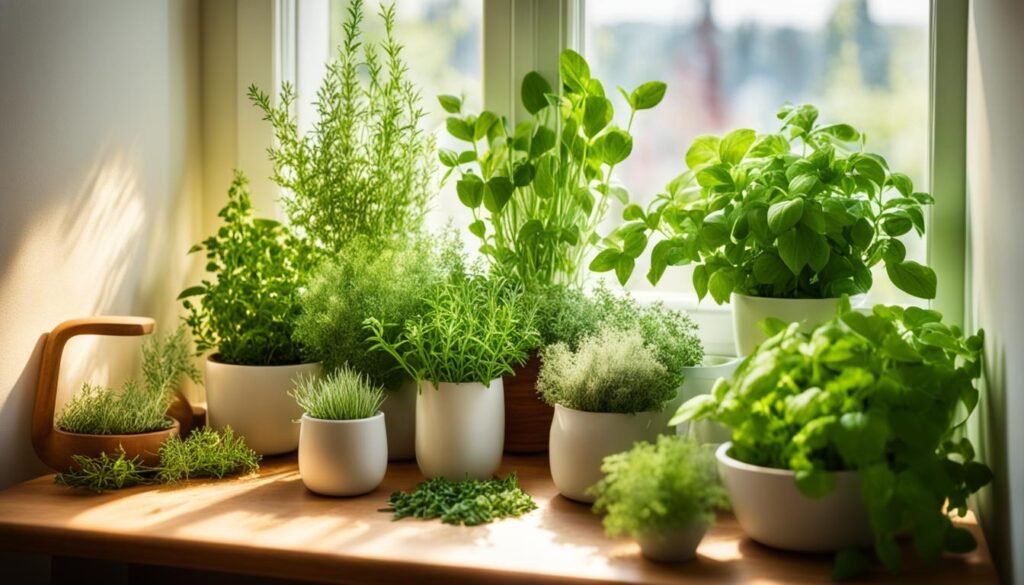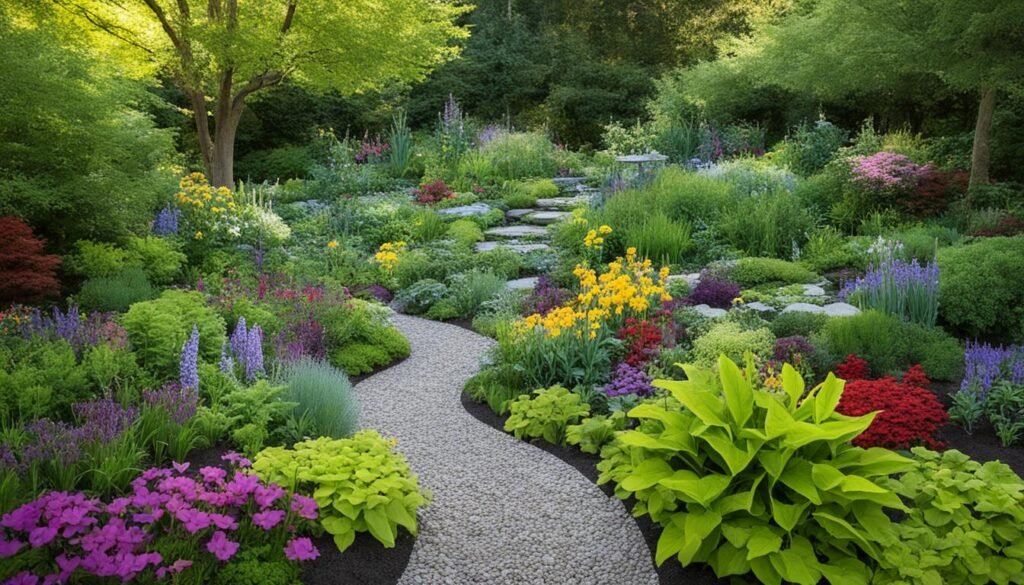Ever dreamed of growing your own fresh herbs in your kitchen? You don’t need a big backyard to do it. With the right tips and tricks, you can have a thriving indoor herb garden. This guide is perfect for beginners or those with limited space. It will show you how to grow herbs indoors and improve your cooking with fresh flavors.
Do you find it hard to keep indoor plants alive? Or are you new to herb cultivation and don’t know where to begin? This article is here to help. It’s packed with expert advice to help you grow a vibrant indoor herb garden. Your kitchen will soon be the envy of all your friends.
Choosing the Right Herbs for Indoor Gardening
Choosing the right indoor garden herbs is key to success. Whether you’re growing a herb garden on your windowsill or in a potted herb setup, knowing what each kitchen herb needs is important. This knowledge helps you get a good harvest and tasty dishes.
Low-Maintenance and Versatile Herbs
For new indoor gardeners or those with little space, some herbs are great picks. Basil, mint, rosemary, and thyme are tough and versatile for herb cultivation. They do well in indoor gardening, need little care, and are great for cooking.
Understanding Growing Requirements
Before starting your windowsill gardening, learn what each herb needs. Some potted herbs like well-draining soil and lots of sunlight. Others can handle shade. Things like temperature, humidity, and how often to water also matter for herb growing. By meeting each culinary herb‘s needs, you can make an indoor garden that thrives and gives you lots of herbs.
Thriving Indoor Herb Garden: Setting Up Your Space
Creating a successful indoor herb garden means paying attention to the lighting. Each herb has its own light needs. It’s important to give your plants the right amount of light for them to grow well. Let’s look at the key lighting factors for a thriving indoor herb garden.
Lighting Conditions for Optimal Growth
Most kitchen herbs like basil, thyme, and rosemary love bright, direct sunlight. They need at least 6 hours of sunlight daily. Some herbs, like mint and oregano, need even more light.
If your space lacks enough natural light, use artificial lights like LED or fluorescent grow lights. These can help your herbs grow well.
For herbs that like partial shade, such as parsley and chives, place them near a south-facing window. Or use a mix of natural and artificial light. Watch your herbs and adjust the light as needed to keep them healthy.
- Bright, direct sunlight for herbs like basil, thyme, and rosemary
- Partial shade for herbs like parsley and chives
- Supplemental artificial lighting, such as LED or fluorescent grow lights, for areas with limited natural light
Knowing what your indoor herb garden needs in terms of light lets you create the best environment. This way, you’ll have a steady supply of fresh, tasty herbs all year.

Caring for Your Indoor Herb Garden
Looking after an indoor herb garden takes some effort, but it’s worth it. With a few simple steps, your kitchen herbs will stay healthy and fresh. They’ll also add a burst of flavor to your meals.
Watering Your Herbs
Watering is key for a successful indoor herb garden. Keep the soil moist but not soaked. Water when the top inch of soil feels dry. Check the soil often to avoid mistakes.
Too much water can cause root rot, while too little can make herbs wilt. So, find a balance.
Fertilizing for Optimal Growth
Feeding your herbs with a balanced fertilizer helps them grow well. Use a formula made for herbs or indoor plants. This ensures they get the right nutrients.
But, don’t overdo it. Too much fertilizer can make your herbs grow tall and weak.
Pruning and Harvesting
Pruning and harvesting are vital for a healthy herb garden. Cut off leaves and stems as you need them, but don’t take too much. This keeps your herbs bushy and productive.
| Herb | Watering Needs | Fertilizer Requirements | Pruning Recommendations |
|---|---|---|---|
| Basil | Keep soil moist, water when top inch dries | Fertilize every 2-3 weeks with balanced liquid fertilizer | Prune regularly, snip off leaves and stems as needed |
| Thyme | Allow soil to partially dry between waterings | Fertilize every 4-6 weeks with balanced liquid fertilizer | Prune lightly to maintain compact, bushy growth |
| Mint | Keep soil consistently moist | Fertilize every 2-3 weeks with balanced liquid fertilizer | Prune frequently to prevent overgrowth and maintain shape |
By following these tips, your indoor herb garden will flourish. You’ll have a steady supply of fresh herbs for your cooking.

Harvesting and Using Your Fresh Herbs
Once your indoor herb garden is doing well, it’s time to learn how to harvest properly. This ensures your herbs keep producing and lets you use them in your cooking.
Proper Harvesting Techniques
When you harvest your kitchen herbs, do it right. Just cut the leaves or stems, leaving 1-2 inches for growth. This way, the plant can keep thriving. Don’t pull or tear the leaves, as it can hurt the plant. Cutting your herbs often makes them grow bushy and you can keep harvesting all season.
Incorporating Fresh Herbs into Recipes
Growing your own culinary herbs lets you add their fresh flavors to your dishes. You can sprinkle basil on homemade pizza or use dill on grilled salmon. Try adding fresh herbs to salads, soups, sauces, and even cocktails for a natural taste boost.
FAQ
What are the best herbs to grow indoors?
Great indoor herbs include basil, mint, thyme, rosemary, parsley, and chives. They’re easy to care for and do well indoors.
How much light do indoor herbs need?
Herbs need about 6 hours of sunlight daily. If your space lacks enough light, use grow lights to help them grow.
How often should I water my indoor herbs?
Water herbs when the top inch of soil feels dry. But don’t overwater, as it can cause root rot.
Can I grow herbs in containers on my windowsill?
Yes, growing herbs on a windowsill is a great idea. Use pots that are at least 6 inches deep and get enough sunlight.
How do I harvest my indoor herbs without damaging the plant?
Cut your herbs with sharp scissors or shears, leaving 1-2 inches of growth. This helps them keep growing well and stay full.
How can I use my fresh, homegrown herbs in the kitchen?
Use your herbs in salads, soups, sauces, marinades, and cocktails. You can also infuse oils and vinegars with them or dry them for later.

